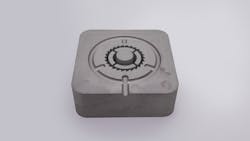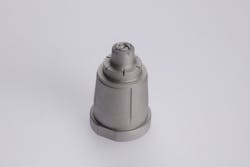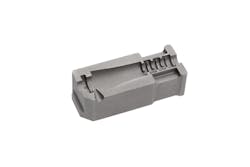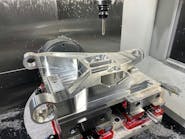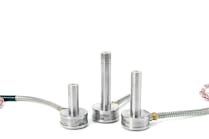A new 3-D printer that extrudes a metal slurry with the consistency of toothpaste could leave mold makers and buyers smiling, thanks to its ability to produce mold components more quickly and at less expense than traditional methods.
Known as TrueShape, the technology from San Francisco-based Mantle combines additive and subtractive processes to create mold inserts and other components. The printer, which is capable of making parts with dimensions as big as 8 inches by 8 inches by 6 inches, hit the market this spring. Also, included with the TrueShape package are a furnace, used to sinter parts after they are out of the printer, and a cart that helps shuttle the parts between the two.
In setting its sights on the $45 billion mold and tooling industry, Paul DiLaura,the company’s chief commercial officer, said the TrueShape printer offers three primary benefits: faster production times, lower costs and the ability to manufacture conformal cooling channels that can cut molding cycle times.
TrueShape’s official launch is accompanied by some stats it has racked up in two years of testing. In one case, a global manufacturer of dishwashers replaced one of four existing components in a high-volume injection mold with a component made by a TrueShape printer. The TrueShape component took less than two days to produce and cost $624, compared to one week and $1,875 for each of the other components. Though the four components were produced in different ways, they have proven identical in form and function; a routine maintenance check found all four components were still going strong after 200,000 molding cycles.
Cosmetics giant L’Oréal, which has used the TrueShape printer to fabricate precision mold components for packaging, also lauded the printer’s advantages.
“Mantle’s TrueShape technology delivered the dimensional tolerances and surface finish that are needed for the precision molds we use at L’Oréal,” said Blake Soeters, director of product conception for the company. “We are excited because of the positive impact this technology will have on our ability to rapidly bring new products to market.”
Compared with other 3-D metal printers, the TrueShape is more precise, DiLaura said. Key to the process is the material: a choice of two specially formulated, high-hardness steels blended with a liquid binder to create a paste that can beextruded in layers. The steels satisfy the requirements of about 60 percent of all tooling that’s created for the molds and tooling market, DiLaura said.
“We build up the part layer by layer. We extrude out the paste, and build this up, layer by layer in the shape of the CAD file. And so, as we’re depositing that paste and building it up layer by layer, we actually heat and dry the paste, which removes the liquid components, and we’re left with the metal particles,” he said.
The resulting part, like many produced by 3-D printing, is rough, but the TrueShape’s process doesn’t stop there.
“The next thing that we do inside of our machine is we CNC it. Our printers themselves include components for CNC. And so, we go over and mill or machine the part in order to create the fine features and the accuracy and the detail that’s needed for tooling,” DiLaura said. As a final step, the parts are heated to burn off any residual liquid binder.
“The printing and shape refinement happen within one piece of equipment, which we call the printer,” DiLaura explained. “The sintering happens in another piece of equipment, which is the furnace. We refer to the entire process (printing, shape refinement, and sintering with our materials and software) as the TrueShape process.”
During a video call, he showed off inserts created by the process, including onemold component used to produce a kit to test for the presence of the coronavirus. He emphasized the TrueShape’s capabilities to produce parts that are accurate to within one-half the width of a human hair and perfectly smooth — requirements for tooling that traditional mold-making processes handle with aplomb.
TrueShape is the first 3-D printer especially designed to meet these challenges, he said.
“In order to address the tooling requirements, you have to have very good surface finish and very good accuracy. And when we look at the landscape of other metal 3-D printing processes, they lack that. They generally do not meet the requirements for surface finish and accuracy … unless there’s a lot of post-processing,” he said.
Being able to focus on tooling requirements means Mantle is able to home in on the needs of its customers, he said.
“The requirements for making tools are very different than the requirements for making aircraft parts. … There are different materials that are required for different applications; that’s one thing. Another thing that’s unique is the manufacturing requirements; the quality requirements for each of theseapplications are different. You have to be able to meet a certain level of surface finish and accuracy and repeatability,” DiLaura said.
In addition to the other advantages it offers, the TrueShape, like many 3-D printers, can create parts with shapes, such as conformal cooling channels, that could not be produced via conventional means.
DiLaura said Mantle is targeting three groups with the technology: mold makers, brand owners of injection molded parts and injection molders that either make their own molds or would be interested in being able to replace or repair inserts in-house.
While it can’t replace traditional methods of mold making, TrueShape provides more options to manufacturers and gives them greater flexibility and design freedom. For molders, in particular, it creates the option of doing some work in-house.
“In the supply chain, mold makers can be more responsive to their customers, can be located geographically closer to their customers. A lot of companies get their molds made overseas, and this allows for some onshoring of mold making, to make it more efficient and more cost-effective,” DiLaura said.
By making it possible to create inserts more cheaply and quickly, he said the TrueShape also opens new avenues for part makers to tinker with their designs. This could allow even them to produce prototypes more quickly, because they'll be able to make — and modify — key mold components in-house.
“We just make the tool making process more efficient, so the engineers can still design their tools the way they wanted to. They can use the materials they want to; they can use the mold making and molding processes and the supply chains that they’re accustomed to. But we just make the process of making the molds more efficient, more cost-effective, and give them some new freedoms to make conformal-cool inserts and things that would allow for superior molding performance,” he said.
Karen Hanna, associate editor
Contact:
Mantle Inc., San Francisco, 415-655-3555, www.mantle3d.com
Related stories
From prototypes to production, manufacturers harness evolving 3-D technology.
Printing's advantages shine in pandemic, says 3DChimera co-founder.
Rize executives say printing offers personalization at push of a button.
Stratasys to launch production-scale 3-D printers.
Industry survey finds use of AM is expanding beyond prototyping and R&D.
3YourMind sees a growing market for printing spare parts.
Jabil develops a new high-strength filament to meet customer demand.
Additive manufacturing grew in 2020 despite pandemic, says Wohlers Report.
Karen Hanna | Senior Staff Reporter
Senior Staff Reporter Karen Hanna covers injection molding, molds and tooling, processors, workforce and other topics, and writes features including In Other Words and Problem Solved for Plastics Machinery & Manufacturing, Plastics Recycling and The Journal of Blow Molding. She has more than 15 years of experience in daily and magazine journalism.
